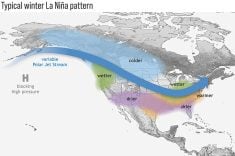A new variation on an old grain is showing promise in pig-feeding trials at North Dakota State University.
Swine nutritionist Bob Harrold fed rations containing naked or hulless oats and barley to growing and finishing pigs, and found good growth and performance. In fact, pigs on naked-oats-only diets performed similar to pigs on all-corn diets.
Unlike traditional oats, naked varieties lose their hull during harvest.
“We’re looking to optimize the use of some of these northern-grown grains,” said Harrold. “We felt that naked oats, with high protein and energy levels, would be a good complement to barley.”
Read Also

Canadian Food Inspection Agency extends chronic wasting disease control program consultation deadline
Date extended for consultation period of changes to CWD program
Naked oats are palatable with high-quality protein, Harrold said.
A limited amount of naked oats has been planted since 1994 when NDSU oat breeders released Paul, the first commercially available variety of the crop in the United States.
In Canada the registered variety is AC Belmont.
Although the crop requires some adjustments in planting and fertilization compared to typical oats, it is attracting attention from farmers. In traditional oats, up to 25 percent of the yield is hulls. Without hulls, oats pack more of a nutritional punch in a smaller package, making them easier to ship. They also require less processing for some applications.
Value-added markets
Producers are searching for a high-value market for the crop to make up for its yield, which is significantly lower than traditional oats.
One market may be in livestock feed. Early research in feeding the crop to young pigs at the university’s Dickinson research extension centre and beef cattle at the Carrington research extension centre have shown promise.
In Harrold’s trials, pigs were raised from about 55 pounds to about 240 pounds. Average daily gains on naked oats were similar to gains seen in pigs on corn diets, but the pigs gained more weight with less feed when fed naked oats.
Carcass measurements of lean gain and other characteristics were also similar to corn-fed pigs. There is a possibility carcass characteristics could be improved by fine-tuning the diet, Harrold said. Higher nutrient concentrations might boost carcass characteristics of pigs fed diets high in naked oats.
“The bottom line is, pigs on the naked oat diets gained like crazy,” Harrold said. “We were very competitive in regard to animal performance.”
Adding barley to the diet cut average daily gain, but not excessively. It also reduced cost of the ration.
“Our goal is to come up with a low-cost ration that’s comparable in performance and price to corn,” Harrold explained.














